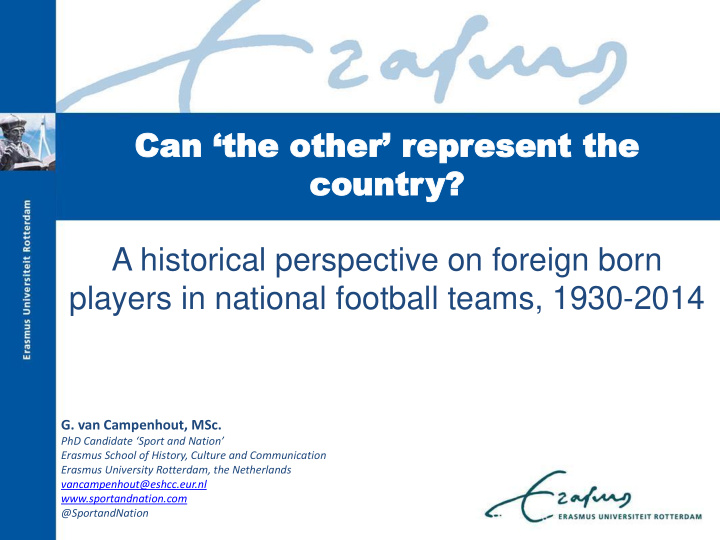



Can ‘the other’ represent the countr country? y? A historical perspective on foreign born players in national football teams, 1930-2014 G. van Campenhout, MSc. PhD Candidate ‘Sport and Nation ’ Erasmus School of History, Culture and Communication Erasmus University Rotterdam, the Netherlands vancampenhout@eshcc.eur.nl www.sportandnation.com @SportandNation
Club football vs. National football teams Brazil 2014: Visualising ancestral and international connections between teams From: The Telegraph (2015) From: Codehesive (2014) Henry Winter and James Offer Tom Shiel (graphic)
French squad without migrants Steve Mandanda Rod Fanni Samir Nasri
Foreign born football players • Increase of foreign born football players representing national teams in FIFA World Cup → A new phenomenon? • “How, and why, has the number of foreign born football players in FIFA World Cup changed between 1930- 2014?” • Database on international football players – Historical overview on nationality changes is lacking – Qualified teams for FIFA World Cups 1930-2014
Database 1) Setting up a database: searching data – Biographical data & information on parental heritage – Scraping data from Wikipedia 2) Classifying data – Who counts as a foreign born football player? – ‘Foreign born’ versus ‘(foreign) national’ 3) Generating output – 10.000 cases (not all unique) – Relate to international migration trends
Who counts as ‘ foreign born’? • Mostly used in international migration studies “All people who have ever migrated from their country of birth to their current country of residence ” ( OECD, 2017) • Useful, but lacking (historical) context – Territorial changes of borders – Colonial relations • Three perspectives on ‘foreign born’ 1) Using current state borders (anno 2014) 2) Borders at the time of FIFA World Cups Colonial relationships related to players’ date of birth 3)
Perspective 1: 2014 Borders PERCENTAGE FOREIGN-BORN FOOTBALL PLAYERS 1930-2014, PERSPECTIVE 1 [#CASES: 913] 16,00% 13,96% 14,00% 12,57% 12,22% 11,95% 11,93% 11,75% 12,00% 11,55% 10,73% 9,65% 9,63% 10,00% 8,71% 8,94% 8,87% 8,52% 8,21% 8,16% 7,67% 8,00% 5,68% 6,00% 5,46% 4,00% 2,27% 2,00% 0,00% 1930 1934 1938 1942 1946 1950 1954 1958 1962 1966 1970 1974 1978 1982 1986 1990 1994 1998 2002 2006 2010 2014
2014: French foreign born players
Perspective 2: Border changes PERCENTAGE FOREIGN-BORN FOOTBALL PLAYERS 1930-2014, PERSPECTIVE 2 [#CASES: 623] 12,00% 11,41% 10,33% 10,00% 9,09% 8,56% 8,33% 8,18% 8,00% 7,38% 7,04% 5,85% 6,00% 5,33% 5,12% 4,83% 4,62% 4,61% 3,69% 4,00% 3,44% 3,13% 2,84% 2,27% 1,70% 2,00% 0,00% 1930 1934 1938 1942 1946 1950 1954 1958 1962 1966 1970 1974 1978 1982 1986 1990 1994 1998 2002 2006 2010 2014
Disintegrated States - Yugoslavia Yugoslavia: World Youth Champions 1987
Perspective 3: Colonial Ties PERCENTAGE FOREIGN-BORN FOOTBALL PLAYERS 1930-2014, PERSPECTIVE 3 [#CASES: 578] 12,00% 11,41% 10,19% 10,00% 8,68% 8,42% 7,95% 8,00% 6,66% 6,45% 6,29% 6,00% 5,28% 4,93% 4,83% 4,61% 4,19% 3,78% 4,00% 3,44% 3,13% 2,84% 1,70% 2,00% 1,14% 1,14% 0,00% 1930 1934 1938 1942 1946 1950 1954 1958 1962 1966 1970 1974 1978 1982 1986 1990 1994 1998 2002 2006 2010 2014
Foreign / Colonial Nationals Dutch international Bep Bakhuys (1934) Portuguese national football team in 1966
A quick interpretation PERSPECTIVES FOREIGN-BORN FOOTBALL PLAYERS AND INTERNATIONAL MIGRANTS Foreign Born P1 Foreign Born P2 Foreign Born P3 Migrants 16,00% 14,00% 12,00% 10,00% 8,00% 6,00% 4,00% 2,00% 0,00% 1920 1930 1940 1950 1960 1970 1980 1990 2000 2010 2020
Thank y hank you f ou for or your a our attention ttention Ques Questions? tions? G. van Campenhout, MSc. PhD Candidate ‘Sport and Nation ’ Erasmus School of History, Culture and Communication Erasmus University Rotterdam, the Netherlands vancampenhout@eshcc.eur.nl www.sportandnation.com @SportandNation
Recommend
More recommend